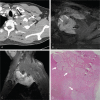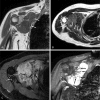Desmoid-Type Fibromatosis of the Thorax: CT, MRI, and FDG PET Characteristics in a Large Series From a Tertiary Referral Center
- PMID: 26402812
- PMCID: PMC4635752
- DOI: 10.1097/MD.0000000000001547
Desmoid-Type Fibromatosis of the Thorax: CT, MRI, and FDG PET Characteristics in a Large Series From a Tertiary Referral Center
Abstract
The purpose of this study was to describe the radiologic findings of computed tomography (CT), magnetic resonance (MR) imaging, and ¹⁸F-fluorodeoxy glucose positron emission tomography (FDG PET) in desmoid-type fibromatosis of the thorax. We retrospectively evaluated 47 consecutive patients with pathologically proven desmoid-type fibromatosis from January 2005 to March 2015. Patients underwent CT (n = 36) and/or MR (n = 32), and 13 patients also underwent FDG PET. Based on CT and MR, the sizes, locations, margins, contours, presence of surrounding fat, extra-compartment extension, bone involvement, and neurovascular involvement of the tumors were recorded. The attenuation, signal intensity, enhancement pattern, and presence of internal low signal band or signal void of the tumors were evaluated. Initial image findings were then compared between 2 groups of tumors: group 1 with recurrence or progression, and group 2 with no recurrence or stable without treatment. Median age at diagnosis of the tumors was 45 years, range 4 to 96, female-to-male ratio 1.8. Median tumor long diameter was 65 mm (range, 22-126 mm). The most common locations were chest wall (42.6%), followed by supraclavicular area, shoulder or axillary area, and mediastinum. The tumors had well-defined margins (83.0%), lobulated in contours (66.0%) surrounding fat (63.8%), extra-compartment extensions (42.6%), bone involvements (42.6%), and neurovascular involvements (27.7%). On CT, tumors had low attenuation (60.0%) with mild enhancement (median 24 HU, range 0-52). On MR, they showed iso-signal intensity (SI) (96.9%) on T1-weighted images (WI), and high SI (90.6%) on T2WI images, with strong (87.5%) and heterogeneous (96.9%) enhancement. Internal low signal bands (84.4%) and signal voids (68.8%) were noted. The median value of maxSUV was 3.1 (range, 2.0-7.3). In group 1 (n = 19, 40.4%), 13 patients suffered recurrence and 6 experienced progression. Group 2 (n = 28, 59.6%) consisted of 21 patients with no recurrence and 7 stable patients receiving no treatment. Partially ill-defined margins (OR, 0.167; 95% CI 0.029-0.943; P = 0.043) was the independent predictor for recurrence or progression of tumor. Knowledge of the radiological findings in desmoid-type fibromatosis on CT, MR, and FDG PET may help to improve diagnosis. Tumors with partially ill-defined margins have a tendency to recur or progress.
Conflict of interest statement
The authors have no funding and conflicts of interest to disclose.
Figures





References
-
- Weiss SW, Goldblum JR, Flope AL. Enzinger and Weiss's Soft Tissue Tumors: Expert Consults. 6th ed.2014; Philadelphia: Saunders Elsevier, 288–293.
-
- Fletcher CD, Unni KK, Mertens F. Pathology and Genetics of Tumours of Soft Tissue and Bone. 2002; Lyon: IARC Press, 83.
-
- Hosalkar HS, Torbert JT, Fox EJ, et al. Musculoskeletal desmoid tumors. J Am Acad Orthop Surg 2008; 16:188–198. - PubMed
-
- Nuyttens JJ, Rust PF, Thomas CR, Jr, et al. Surgery versus radiation therapy for patients with aggressive fibromatosis or desmoid tumors: a comparative review of 22 articles. Cancer 2000; 88:1517–1523. - PubMed
-
- Janinis J, Patriki M, Vini L, et al. The pharmacological treatment of aggressive fibromatosis: a systematic review. Ann Oncol 2003; 14:181–190. - PubMed
Publication types
MeSH terms
Substances
LinkOut - more resources
Full Text Sources

